
Good day! I have long wanted to have a camping, so-called “camping” lantern. Which can be put on / hung over the table, in order to eat not to the touch, well, or a cat to plant for the story of a true story. Of the features required a long time and adjustable brightness.
A 10W LED, which came from China for a long time, and a lens of a blown LED lamp, came under the arm. As a source of energy, I took a pair of 18,650 at 2500 mA / h each. Then I began to think about the current source for the LED. At first, I wanted to use a microcontroller, but to understand the principles of the implementation of a PWM controller with a throttle was furious. I found a good old DC / DC converter controller - 34063. It remains to run it in “step up” mode with current stabilization.
The choice of the type of controller was also influenced, by the variable resistor with a recessed stem, found in the same bins. The limits of the limiting resistors of the brightness control limits have been established empirically.
To protect batteries from overdischarge, a Chinese module is used to protect batteries against overcharging / overdischarge. To charge the already protected batteries, a Chinese module is also used to charge LiIon. The unreliable microUSB connector was ruthlessly cut off and the power connector removed from the router's dead body was inserted. An indication of the charging status from the module board was brought to the surface. The module itself was cut to a circle with a diameter equal to the diameter of the battery.
After checking the operation of the converter on the model, the design of the lamp housing in FreeCADe began.
From the nuances I note:
- suspension eye;
- controls are displayed on the rear end;
- recessed power switch, so that you can put the lamp on the surface;
Printed in blue abs.
Here is a flashlight before final assembly. Results: At maximum brightness, the measured current consumption is 500mA. It turns out that in this mode, with a total battery capacity of 5000 mA / h, the operating time will be about 10 hours. With an average brightness consumption is 100 mA, respectively, 50 hours of operation. After field tests I will add article with actual values.
From the alleged comments, I will immediately answer:
- yes, get wet, if you dip into the water or long to keep in the rain;
- yes, in the cold LiIon discharges very quickly and does not charge;
- if you need a model of the case - I can lay out.
Thank you for reading. Write comments.